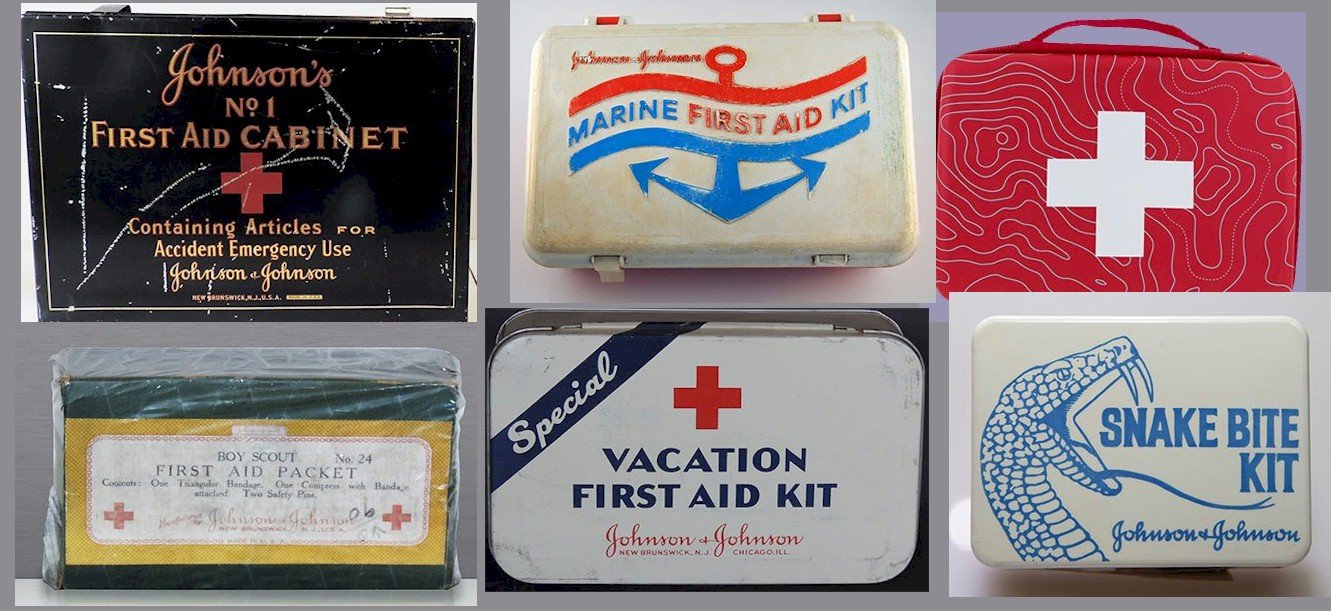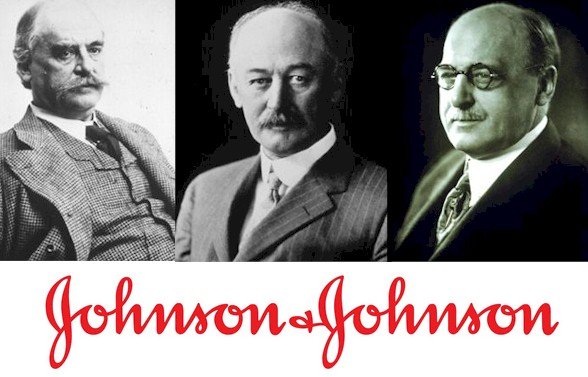A look at the Johnson & Johnson Logo and Its History.
Johnson & Johnson (J & J) is one of the most highly regarded companies in the United States. It’s one of the world’s largest healthcare companies as well.
The firm’s renowned line of products includes the Neutrogena Hair and Skin Care products, Johnson’s Baby Care products, Motrin and Tylenol pain relievers, Stayfree and O.B hygiene products, Band-Aid® Adhesive Bandages, Reach Oral Care products, Pepcid AC acid regulator, Mylanta gastrointestinal products, and Imodium A-D Diarrhea medication.
Around 50% of Johnson & Johnson’s revenue is generated outside America through its 190 operating firms in over 57 countries around the world. Moreover, its marketing operation is found in over 175 countries around the globe.
The History of Johnson & Johnson
Johnson & Johnson was founded by three brothers—Edward Mead Johnson, James Wood Johnson, and Robert Wood Johnson—in 1886 in the city of New Brunswick, New Jersey. It’s believed that after hearing an address by antiseptic crusader Joseph Lister, the Johnson brothers were so touched that they decided to establish a company that produces a range of readymade surgical dressings.
Robert Wood Johnson was appointed the company’s first president, and the business was incorporated in 1887. Throughout the rest of the 19th century, Robert endeavored to make sanitation practices better.
 In 1888, J & J made the first marketable first aid kits, initially to help out railroad employees. But the products immediately became the standard solution for treating injuries. Johnson & Johnson started their heritage baby care product line in 1894 by launching maternity kits. The kits were designed to make childbearing safer for mothers and their babies. During the same year, Johnson’s Baby Powder went on sale, too, and was enormously successful.
In 1888, J & J made the first marketable first aid kits, initially to help out railroad employees. But the products immediately became the standard solution for treating injuries. Johnson & Johnson started their heritage baby care product line in 1894 by launching maternity kits. The kits were designed to make childbearing safer for mothers and their babies. During the same year, Johnson’s Baby Powder went on sale, too, and was enormously successful.
From 1896 to 1897, Johnson & Johnson took another huge leap forward when it made the first mass-produced sanitary pads for women.
In 1910, Robert Wood Johnson died, and his brother James succeeded him as president. In 1932, Robert Wood Johnson 2, James’ son, became president.
Ethicon is one of J & J subsidiaries and manufactures wound closure devices and surgical sutures. It was inaugurated as a separate firm in 1949 in order to diversify and expand the Johnson & Johnson product line. After the Second World War, Ethicon sold 70% of the world’s surgical sutures, up from 15%.
In 1959, Johnson & Johnson bought McNeil Laboratories in America, as well as Europe’s Cilag Chemie. These two acquisitions helped the firm to make serious forays into the pharmaceutical medicine market for the first time.
Under J & J, one McNeil product, Tylenol (which was the first-ever kid’s prescription aspirin-free pain reliever), became available over the counter a year later. It also became the most recommended pain reliever by pediatricians and doctors, according to the firm’s history.
The Partnership with Janssen
In 1961, Janssen Pharmaceutica N.V. from Belgium joined the Johnson & Johnson group of companies. Today, Janssen has become one of the leading research-based pharmaceutical companies in the world and sells prescription medications in the fields of women’s health, gastroenterology, mental health, HIV/AIDS, and neurology to mention a few.
Under the common J & J brand name, Janssen is now divided into three separate businesses—Janssen Healthcare Innovation, Janssen Diagnostics, and Janssen Research & Development. Some of the most popular Janssen consumer products include diarrhea medication Immodium (Loperamide), Alzheimer’s disease medicine Reminyl (Galantamine), and antipsychotic Risperdal (Risperidone).
Johnson & Johnson in 1970s and Beyond

From 1976 to 1989, James E. Burke served as CEO and Chairman of Johnson & Johnson. During this tenure, the company ventured into the fields of diabetes management, mechanical wound closure, and vision care. Also, it was during this period that the company launched its first operating firms in Egypt and China.
During the 1990s, Endo-Surgery from Ethicon helped with performing the first ever minimally invasive surgery, using very tiny incisions. This type of surgery helps patients heal quicker than with conventional surgery.
1994, J & J created the first-ever coronary stent known as Palmaz-Schatz stent. Coronary stents keep your blood vessels open so that blood can freely move to the heart, so this move helped to revolutionize cardiology.
Later, Cordis Corporation, another of Johnson & Johnson companies, released the first medicine-eluting coronary stent, which helped prevent the reclogging of arteries. Cordis was established in 1959 in Miami and develops and manufactures medical equipment for treating patients with cardiovascular disease.
In 2002, William C. Weldon took over as the CEO and Chairman of Johnson & Johnson. Under his stewardship, the company ventured into new therapeutic fields. One of them was HIV/AIDS when the company acquired Tibotec-Virco BVBA to cater to the massive unfulfilled needs of HIV/AIDS and tuberculosis patients.
In 2006, Johnson & Johnson spent $16.6 billion to acquire Pfizer Consumer Healthcare. The acquisition included leading global brands like the Listerine Oral Care line of products, as well as Nicorette smoking cessation products.
Johnson & Johnson Today

In 2012, Alex Gorski was appointed CEO of Johnson & Johnson.
Today, the company boasts more than 250 subsidiary firms, with operations in more than 57 countries around the globe. In addition, its products are sold in more than 175 countries worldwide. J & J focuses on three key fields: consumer, diagnostics and pharmaceuticals, and medical devices.
In 2012, J & J’s global sales were worth $67.2 billion, while research and development cost about $7.7 billion.
While there’s no way to predict how Johnson & Johnson’s future will look like, the firm’s pharmaceutical segment has its own future mapped out after announcing plans to develop ten new products in the not-too-distant future. These products are intended to address serious unfulfilled medical needs, including influenza, schizophrenia, and Hepatitis C.
In 2012, Johnson & Johnson’s pharmaceuticals section was the quickest growing pharmaceutical business in the United States, Europe, and Japan.
Key Johnson & Johnson Timelines

1886: Johnson brothers start making dressings in the city of New Brunswick, New Jersey.
1887: The firm is registered and named Johnson & Johnson.
1893: Johnson & Johnson introduces Johnson’s Baby Powder.
1921: Band-Aid® adhesive bandages are released to the market.
1924: Overseas expansion starts when Johnson & Johnson Ltd is established in Britain.
1932: Robert Wood Johnson II, affectionately referred to as “the General”, becomes the company’s president.
1943: Robert Johnson writes the firm’s credo.
1944: J & J goes public for the first time on the NYSE (New York Stock Exchange).
1959: J & J acquires McNeil Labs (Mc Neil Laboratories Inc.).
1960: McNeil Labs releases Tylenol as a nonprescription (over-the-counter) pain reliever.
1961: J & J acquires Janssen Pharmaceutica, N.V.
1975: Through a dramatic price drop, Tylenol is turned into a mass-produced and mass-marketed product.

1982: Tylenol tampering disaster takes place.
1988: J & J introduces Acuvue single-use contact lenses.
1989: Johnson & Johnson and Merck join forces to develop over-the-counter variants of Merck’s prescription drugs.
1994: J & J acquires Neutrogena Corporation.
1995: J & J and Merck release Pepcid AC; J & J acquires Eastman Kodak Company’s clinical diagnostics unit.
1996: J & J buys Cordis Corporation.
1998: J & J acquires DePuV Inc. and launches a companywide restructuring.
1999: J & J merges with Centocor Inc.
2001: J & J acquires ALZA Corporation for $13.4 billion.
2004: Guidant Corporation is bought by J & J for $25.4 billion.
2006: J & J purchases Pfizer Consumer Healthcare, completing a full historical circle as Joseph Lister’s Listerine brand is brought under J & J’s umbrella.
The Johnson & Johnson Logo and Its History
The company’s logo features the Johnson & Johnson name in some script that resembles handwriting.
The company went for a simpler, cleaner logo like those of most competitors simply because the traditional design is so familiar and recognizable to consumers all around the world. It’d have been too risky for the company to deviate from it.
Johnson & Johnson Logo Evolution
 1886: During the company’s first year of operation, co-founder James Johnson signed the company’s first official check issued to a resident railroad freight master, which included the company’s name written in the same way.
1886: During the company’s first year of operation, co-founder James Johnson signed the company’s first official check issued to a resident railroad freight master, which included the company’s name written in the same way.
1887: Johnson & Johnson’s earliest products, which medical practitioners used for sterile surgical procedures, had a logo that looked like Johnson’s signature, featuring big loops on some letters with an ampersand connecting the first “Johnson” to the second one.
1890s: Johnson & Johnson’s logo started to be seen on horse-drawn carts that delivered products like medicated plasters and first aid kits to local consumers.
1921: As J & J’s business expanded, Johnson’s handwriting was used in a different manner—it was fitted into their products’ package design, including a new baby cream. Put simply, Robert Johnson’s signature inspired the J & J logo that’s on Johnson’s Baby Care products to date.
1950s: From 1900s to 1950s, J & J products had logos in various styles—some of them were quite similar to the current J & J logo, while others resembled real handwriting. But from the 1950s onwards, Johnson & Johnson worked the logo into all of its packaging that consumers see today.
When China allowed Western businesses to set up shop in the country, the J & J logo was written in Chinese on the company’s products, including BAND-AID® adhesive bandages.
2011: In support of sustainability, Johnson & Johnson designed a pioneering solution for its Neutrogena leftover lipstick containers. “Lipstick walls,” portraying the firm’s logo, are now displayed in seven J & J locations in the United States, China, and Brazil.
2016: Johnson & Johnson introduced an animated variant of its logo on the company’s remodeled website, adding a touch of originality to the classic signature.
Johnson & Johnson Logo Design Elements
 The J & J logo contains just the double family name of the company’s founders, connected with an ampersand. This element of visual identity shows that the company has a number of founders with the same surname, and they’re equally involved in the running of the business.
The J & J logo contains just the double family name of the company’s founders, connected with an ampersand. This element of visual identity shows that the company has a number of founders with the same surname, and they’re equally involved in the running of the business.
Moreover, there’s a tiny ligature between the double surname, suggesting an outstretched, friendly open palm of a hand.
The inscription is written in a font that looks like handwriting without tipping to the right side. The letters are lowercase, horizontal, and connected, with no capital letter used. The emblem has a simple color—red, with an accent on the company name on a white backdrop.
————
LogoMyWay offers custom logo designs and the ability to create your own logo using our online logo maker. If you need a medical logo, try our medical logo maker and download your new logo instantly.







